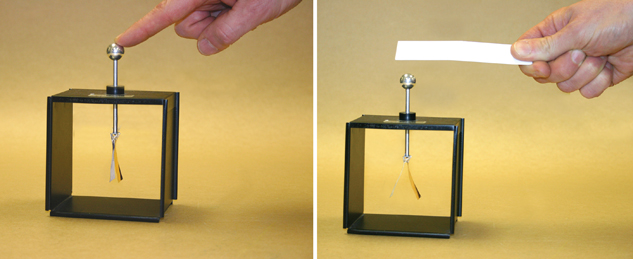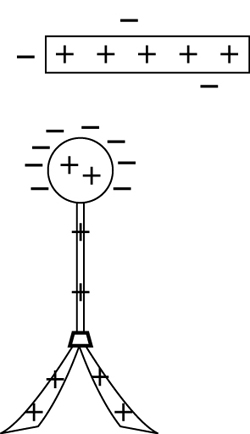Module 3
1. Module 3
1.6. Page 4
Module 3—Electrical Phenomena
Detecting Charge
In the Big Picture for this module, hikers could tell that lightning was about to strike if their skin started to tingle, their hair stood on end, or the pointed tips of metal equipment started to spark or glow. These all acted as detectors of the huge amounts of charge in a thundercloud overhead.
A more sophisticated way to detect the presence of a charged object is to use an electroscope. The most common type of electroscope consists of two thin, metal "leaves" suspended from a metal rod in a container. The conducting metal rod is supported by an insulating rubber stopper to ensure that charges do not pass from the rod to the container.

The photo on the left shows an electroscope that is being grounded by a finger. The leaves on this electroscope are together.
The photo on the right shows an electroscope that is brought near a negatively charged piece of plastic. The leaves on this electroscope repel one another and diverge.
grounding: the process of transferring charge to and from Earth; the symbol for ground is ![]()
Any excess charge on the electroscope can be removed by simply touching the knob with your finger. This is called grounding. Since the leaves are uncharged, they neither attract nor repel. Instead, the leaves hang loosely together.
If a negatively charged object is brought near the knob, the electrons on the knob are repelled, so they migrate to the leaves. Since both leaves are negatively charged, they repel one another and diverge. In the presence of a larger charge, the leaves separate even more.
 Self-Check
Self-Check
You can check your understanding by answering these questions.
SC 11. Compare the electrical conductivity of the metal rod, leaves, and knob with the electrical conductivity of the rubber stopper.
SC 12. Sketch a diagram to show why the leaves of an electroscope diverge in the presence of a negative charge. Remember that only the outermost electrons are free to move in a conductor; therefore, the positive charges remain locked in the nucleus of each atom.
SC 13. Sketch a diagram or provide a written description to show why the leaves of an electroscope diverge in the presence of a positive charge.
 Self-Check Answer
Self-Check Answer
SC 11. The rod, leaves, and knob of the electroscope are made of metal and, therefore, will conduct electricity. Electrons are able to migrate between the knob at the top and the leaves at the bottom since the metal is a conductor.
The stopper that supports the rod is made of rubber, which does not conduct electricity. Electrons would not be able to migrate from the rod to the metal case supporting the electroscope because the stopper is an insulator.
SC 12. The following diagram illustrates the mobility of the electrons by showing the positive charges evenly distributed while the outermost electrons of the atoms migrate to the leaves. Since the leaves are negatively charged, they repel one another and diverge.

SC 13. Again, only the outermost electrons are free to move in a conductor. The following diagram illustrates this point by showing the positive charges evenly distributed while the outermost electrons of the atoms migrate to the top. Since the leaves are left positive, they repel one another and diverge.
